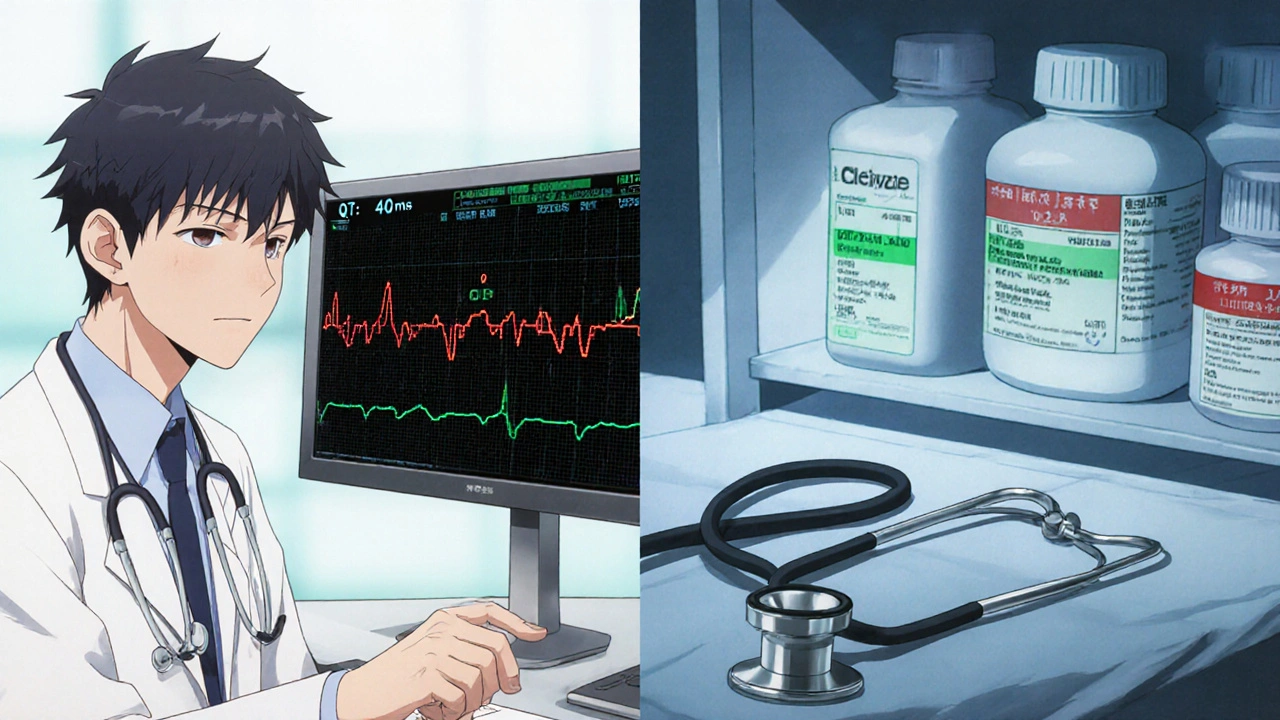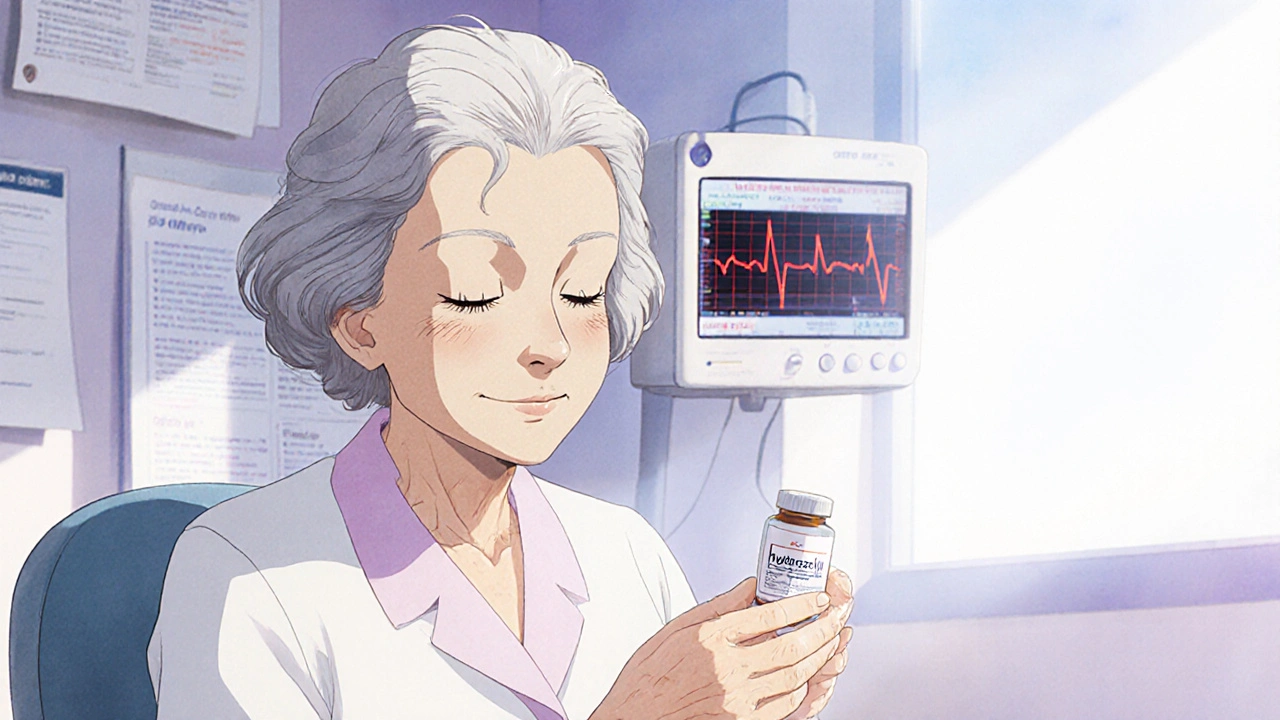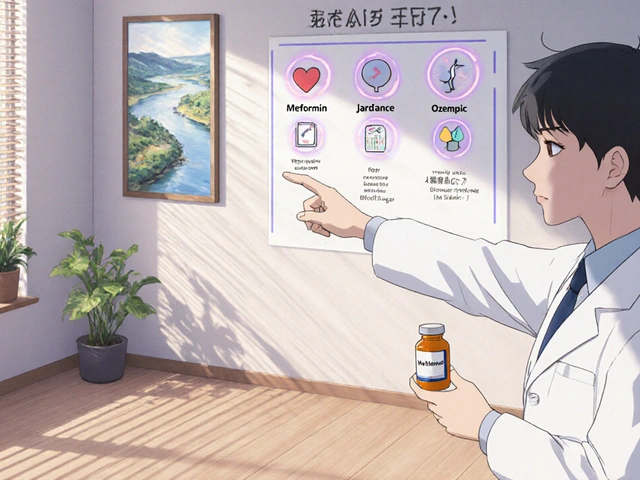Hydroxyzine QT Prolongation Risk Calculator
Risk Assessment Tool
This tool helps determine if hydroxyzine is safe for you based on current medical guidelines.
Warning: This tool is for informational purposes only. Always consult your physician before making treatment decisions.
Risk Assessment Result
Hydroxyzine has been used for over 60 years to treat anxiety, itching, and nausea. It’s cheap, effective, and widely prescribed-especially in older adults and patients with chronic skin conditions. But behind its calming effects lies a quiet, dangerous risk: hydroxyzine can stretch the heart’s electrical rhythm, leading to a life-threatening arrhythmia called Torsade de Pointes. This isn’t a rare rumor. It’s a documented, FDA-recognized danger that’s been quietly reshaping how doctors prescribe it.
How Hydroxyzine Affects the Heart
Hydroxyzine doesn’t just block histamine. It also blocks a critical potassium channel in heart cells called hERG. This channel helps reset the heart’s electrical signal after each beat. When it’s blocked, the heart takes longer to recharge-this delay shows up on an ECG as a prolonged QT interval. That’s not just a number on a graph. A prolonged QT can trigger Torsade de Pointes, a chaotic, fast heart rhythm that can collapse into cardiac arrest.
This isn’t theoretical. Between 1955 and 2016, over 59 cases of QT prolongation or Torsade de Pointes were directly linked to hydroxyzine. Some happened within 10 minutes of taking the first dose. Others showed up days later. One 68-year-old woman with no heart history developed Torsade after a single 50 mg dose for anxiety. She needed emergency cardioversion. Another man, unaware he had inherited long QT syndrome, passed out 15 minutes after taking 25 mg for itching.
Who’s at Risk?
Hydroxyzine isn’t dangerous for everyone. But it’s extremely risky for certain people. The European Medicines Agency (EMA) and FDA now treat it like a cardiac drug, not just an antihistamine.
- Age over 65: Metabolism slows. The drug builds up. The EMA cut the max daily dose for seniors to 50 mg.
- Existing heart conditions: Structural heart disease, heart failure, or prior arrhythmias increase risk.
- Low potassium or magnesium: Common in people on diuretics, dialysis patients, or those with poor nutrition. Even mild imbalances make the heart more vulnerable.
- Other QT-prolonging drugs: Taking hydroxyzine with antibiotics like azithromycin, antidepressants like citalopram, or antiarrhythmics like amiodarone multiplies the danger. One study found 63% of pharmacists had seen hydroxyzine prescribed alongside two or more of these drugs.
- Slow metabolism: People with CYP2D6 poor metabolizer genetics break down hydroxyzine slowly, leading to higher blood levels. A 2023 study showed they’re over three times more likely to develop QT issues.
Here’s the hard truth: if you have one of these risk factors, hydroxyzine should be avoided. If you have two or more, it’s a hard no.
What Doses Are Safe?
Hydroxyzine’s cardiac risk is dose-dependent. Higher doses = higher risk. But even standard doses can be dangerous in vulnerable people.
- Adults under 65: Max 100 mg per day. That’s four 25 mg tablets. Don’t exceed it.
- Adults over 65: Max 50 mg per day. Even that’s pushing it if other risk factors exist.
- Children: 2 mg per kg of body weight, up to 40 kg. Never exceed adult limits.
There’s no safe “low dose” for someone with a long QT interval. If your QTc is above 450 ms (men) or 470 ms (women), hydroxyzine should not be used. Many hospitals now have electronic alerts that block prescriptions if the QTc is too high or if other risky drugs are listed.

How Hydroxyzine Compares to Other Antihistamines
Not all antihistamines are created equal when it comes to heart risk.
| Drug | Generation | QT Prolongation Risk | hERG Blockade | Recommended for High-Risk Patients? |
|---|---|---|---|---|
| Hydroxyzine | First | Known Risk (CredibleMeds) | High | No |
| Diphenhydramine | First | Possible Risk | Moderate | Use with caution |
| Cetirizine | Second | Minimal Risk | Very Low | Yes |
| Loratadine | Second | Minimal Risk | Very Low | Yes |
| Fexofenadine | Second | No Risk | Negligible | Yes |
Second-generation antihistamines like cetirizine and loratadine are far safer. They barely touch the hERG channel. If you need an antihistamine for itching or allergies and have heart risks, switch to one of these. They’re just as effective for symptoms and won’t mess with your heart rhythm.
What Doctors Should Do Before Prescribing
Prescribing hydroxyzine safely now requires a checklist:
- Check the ECG. Get a 12-lead ECG before starting. QTc must be under 450 ms (men) or 470 ms (women).
- Review all meds. Use CredibleMeds to screen for other QT-prolonging drugs. If you’re on one, don’t add hydroxyzine.
- Check electrolytes. Potassium below 4.0 mmol/L and magnesium below 1.8 mg/dL are red flags.
- Assess age and kidney/liver function. Older adults and those with liver disease need lower doses or alternatives.
- Document the decision. Many hospitals now require a checkbox in the EHR: “Cardiac risk assessed.” Only 78% of providers are doing this consistently.
It’s not enough to say, “It’s just an antihistamine.” That mindset got people hurt. Hydroxyzine isn’t a benign sedative anymore. It’s a drug that needs the same caution as a heart medication.

What’s Changing in 2025?
The rules are tightening. In 2025, the European Society of Cardiology is expected to ban chronic hydroxyzine use entirely. It will only be allowed as a single dose for procedural anxiety-like before a dental appointment. No daily prescriptions for anxiety or itching.
Drug makers are also working on safer versions. A new compound called VH-01 is in early trials and shows 87% less hERG blockade than hydroxyzine-while keeping the same anti-itch and calming effects. It could replace hydroxyzine in the next 5-7 years.
Meanwhile, prescriptions are already dropping. In the U.S., hydroxyzine prescriptions fell from 18.3 million in 2014 to 12.7 million in 2022. More doctors are choosing gabapentin for itching or mirtazapine for sleep-both safer for the heart.
What Patients Should Do
If you’re taking hydroxyzine:
- Don’t stop suddenly. Talk to your doctor first.
- Ask: “Has my QT interval been checked?”
- Ask: “Am I on any other drugs that can prolong QT?”
- Ask: “Is there a safer alternative for my condition?”
If you feel dizzy, lightheaded, or notice your heart skipping beats within hours of taking hydroxyzine, seek help immediately. These aren’t normal side effects-they could be early signs of a dangerous rhythm.
Hydroxyzine isn’t evil. It’s useful. But it’s no longer a drug you can take without thinking. The era of treating it like Benadryl is over. The heart doesn’t lie. And if your QT interval is long, hydroxyzine could be the trigger you didn’t see coming.
Can hydroxyzine cause sudden cardiac arrest?
Yes, in rare cases. Hydroxyzine can trigger Torsade de Pointes, a dangerous heart rhythm that can lead to sudden cardiac arrest, especially in people with existing risk factors like low potassium, heart disease, or other QT-prolonging drugs. While the overall risk is low, the consequences are life-threatening.
Is hydroxyzine safe for elderly patients?
Only with extreme caution. The European Medicines Agency recommends a maximum daily dose of 50 mg for adults over 65. Even at that dose, elderly patients are at higher risk due to slower metabolism and more frequent use of other medications. Many experts now consider hydroxyzine inappropriate for older adults, especially if they have any heart or kidney issues.
What are safer alternatives to hydroxyzine for anxiety or itching?
For itching, second-generation antihistamines like cetirizine or fexofenadine are safer and just as effective. For anxiety, non-sedating options like SSRIs or SNRIs are preferred long-term. For short-term anxiety or sleep, low-dose mirtazapine or gabapentin are often used instead, especially in older adults. Always discuss alternatives with your doctor.
Do I need an ECG before taking hydroxyzine?
If you’re over 65, have a history of heart problems, are on other medications, or have electrolyte imbalances, yes. Even if you’re young and healthy, some doctors now recommend a baseline ECG before starting hydroxyzine, especially if it’s being used for more than a few days. It’s a simple, non-invasive test that can prevent a life-threatening event.
How long does it take for hydroxyzine to affect the heart?
It can happen quickly-within 10 minutes-or take up to 20 days. The timing is unpredictable. Some people develop QT prolongation after just one dose. Others develop it after days of use, especially if the drug builds up in their system. That’s why monitoring is crucial, even if you’ve taken it before without issues.
Is hydroxyzine banned in any countries?
No, hydroxyzine is not banned anywhere. But its use is heavily restricted. The EMA and FDA have updated labeling to warn of cardiac risks, lowered maximum doses, and required risk assessments before prescribing. In practice, many hospitals and clinics have stopped prescribing it for chronic conditions like anxiety or itching in high-risk patients.
Final Takeaway
Hydroxyzine still has a place in medicine-but only if you treat it like the cardiac risk it is. It’s not a sleepy-time pill you grab without thinking. It’s a drug that can stop your heart if you ignore the warning signs. If you’re taking it, ask your doctor about your heart health. If you’re prescribing it, don’t skip the ECG. The data is clear: the safest dose is the one you don’t give to someone who doesn’t need it.






